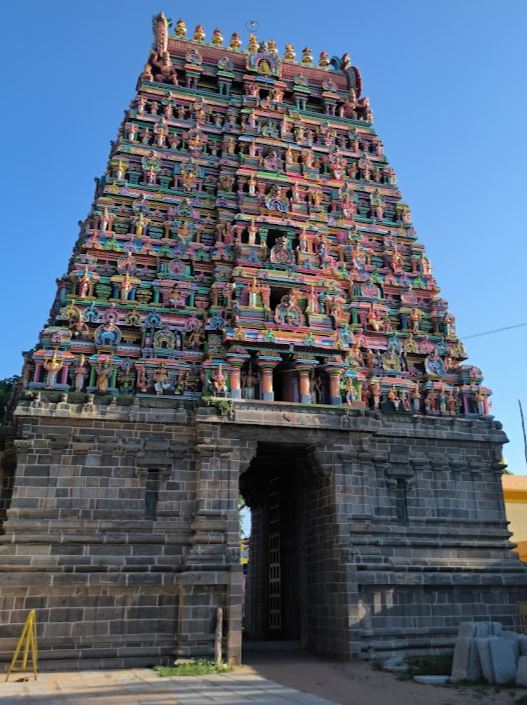Thirugnana Sambandar, one of the revered Saivite saints, was born to Shivapada Hrudayar and Bagavati Ammai. He is regarded as the incarnation of Lord Muruga and is affectionately called Ilaya Pillayar (younger son). According to legend, when Sambandar was a child, his father left him by the Brahma Theertham tank while he went for a bath. Hungry and crying, the child was fed by Mother Parvati, who not only gave him milk but infused it with divine wisdom. Sambandar, with milk spots on his face, was accused by his father of accepting milk from someone else. When the father was about to reprimand him, the boy pointed upwards to show the divine source of the milk. Overjoyed by this revelation, Shivapada Hrudayar was moved and accepted the divine truth. Sambandar’s first hymn, “Thodudaya Sevian,” was composed here, marking the beginning of his contributions to Tamil spiritual literature. He composed 67 hymns of 10 verses each, while Thirunavukkarasar contributed 3 hymns, and Sundarar wrote one hymn in praise of the deity of Sirkali temple.
Sthala Purana :
During the Maha Pralaya, a cataclysmic flood that threatened to destroy the world, Lord Shiva, adorned with 64 arts and travelling in a boat made of the Ohm Moola Mantra, was accompanied by Mother Uma. They noticed that Sirkazhi remained unaffected by the floods and was still alive. Recognizing its sanctity, Shiva chose this place to reside, taking the name ThoniAppar (God with the boat).
At this site, Lord Brahma worshipped Shiva in the form of Brahmapureeswarar (Linga). To demonstrate the unity of Shiva and Vishnu, Shiva wore Vishnu’s skin as a shirt, leading to His recognition as Sattainathar here. Thus, the temple features three forms of Shiva:
- Brahmapureeswarar: Located on the ground floor.
- Thoniappar: Found on the first floor.
- Sattainathar: Situated on the top-most floor.
Sirkazhi is also significant as the place where Lord Shiva imparted spiritual lessons to Mother Parvati during the Maha Pralaya. It is the 11th Shakti Peeta, where Mother Mahalakshmi graces the devotees. The temple uniquely showcases Brahma-Saraswathi, Shiva-Parvati, Vishnu-Mahalakshmi, and the procession deity from the sanctum sanctorum, resembling Mount Kailash.
Lord Bhairava is revered here in eight forms: Asithanga Bhairava, Guru Bhairava, Chanda Bhairava, Krotha Bhairava, Unmatha Bhairava, Samhara Bhairava, Peeshana Bhairava, and Akhala Bhairava. The temple is considered as sacred as Kasi (Varanasi).
The temple also houses the Jeeva Samadhi of SattaiMuni Siddhar, one of the 18 Siddhas.
According to legend, Sage Romasa, who performed penance on Mount Kailash, prayed for Lord Shiva to grant the South a vision of Kailash. During a contest between Vayu and Adisesha about their strength, Adisesha covered Mount Kailash entirely. Unable to move the mount, Vayu requested Adisesha to lift one of his heads slightly, allowing a small part of Kailash to be brought to Sirkazhi by 20 birds.
The temple is structured as a three-tiered hill:
- Base Temple: Features Brahmapureeswarar and Mother Tirumalai Nayaki, known as Lingamurtham. It is said that Lord Brahma, initially proud and believing himself to be the greatest of the deities, was made to forget the Pranava Mantra as a lesson. Upon realising his mistake, Brahma worshipped Shiva here and had his memory restored. Thus, the place is known as Brahmapuram, and the deity is Brahmapureeswarar.
- Middle Temple: Houses Mother Uma and Lord Maheswarar, also known as Thoni Appar.
- Top Temple: Where Lord Sattainathar is venerated.
Thirugnana Sambandar, one of the great Saivite poets, was born to Shivapada Hrudayar and Bagavati Ammai. Regarded as the incarnation of Lord Muruga and known as Ilaya Pillayar (younger son), he visited Brahma Theertham with his father. When left alone, he cried for food, and Mother Parvati fed him both milk and divine wisdom. This act led to the composition of his first hymn, “Thodudaya Sevian,” enriching Tamil spiritual literature. Sambandar composed 67 pathigam’s (hymns) of 10 verses each, Thirunavukkarasar wrote 3 pathigam’s, and Sundarar penned one pathigam in praise of the Lord of Sirkazhi temple.
The temple is known for its swayambhu murti (self-manifested deity) and was significantly expanded during the reigns of Kulottunga Chola I, Vikrama Chola, Kulottunga Chola II, and Kulottunga Chola III, from the 11th the 13th centuries, akin to developments in Chidambaram.
Administrative History:
The Sattainathar Temple is maintained by the Dharmapuram Adhinam, a religious institution responsible for its administration and upkeep. The temple's management ensures that rituals, festivals, and daily operations are conducted according to traditional practices. It is noted for its historical significance, with 47 inscriptions documenting various aspects of its past. The temple's status as the 14th Shiva temple on the northern bank of the Cauvery River, praised in Thevaram hymns, adds to its prominence. The administrative history reflects a long tradition of stewardship and reverence.
